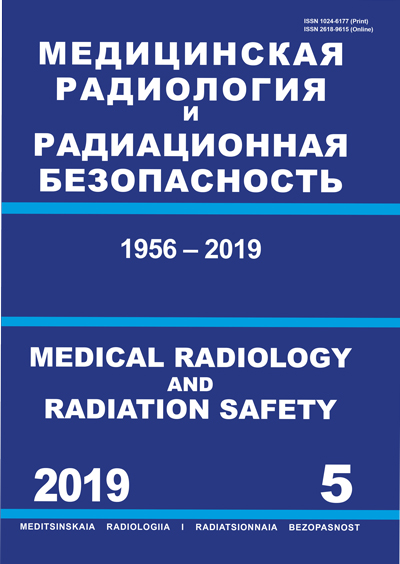Russian Federation
Russian Federation
Russian Federation
Moscow, Russian Federation
Russian Federation
Russian Federation
Russian Federation
CSCSTI 76.03
CSCSTI 76.33
Russian Classification of Professions by Education 14.04.02
Russian Classification of Professions by Education 31.06.2001
Russian Classification of Professions by Education 31.08.08
Russian Classification of Professions by Education 32.08.12
Russian Library and Bibliographic Classification 51
Russian Library and Bibliographic Classification 534
Russian Trade and Bibliographic Classification 5708
Russian Trade and Bibliographic Classification 5712
Russian Trade and Bibliographic Classification 5734
Russian Trade and Bibliographic Classification 6212
Purpose: To clarify the frequency, nosological forms, the timing of development and the features of the clinical course of developed oncohematological diseases on the basis of a retrospective analysis of the results of long-term follow-up of patients who underwent acute radiation syndrome (ARS). Material and methods: An analysis of clinical histories from archives of A.I. Burnasyan Federal Medical Biophysical Center of 157 patients who underwent ARS of varying severity, and some scientific publications. Various oncohematological diseases developed in the long-term period in 8 patients with ARS I–III severity: in 5 patients – myelodysplastic syndromes (MDS), in 2 – chronic myeloid leukemia (CML) and in 1 – acute myelomonoblastic leukemia (OMML). Results: The excess absolute risk of developing MDS and leukemia in the group is 7.2×10–4 man-years/Gy. All patients underwent relatively uniform irradiation. MDS developed in 5 patients who underwent ARS as a result of a single acute gamma-beta- and gamma-neutron irradiation at doses of 1.2–5.0 Gy. Nosological forms of MDS: with unilinear dysplasia, with multilinear dysplasia (2 cases), with ringed sideroblasts, with excess blasts. The latency period lasted from 3 to 31 years. Age at the time of irradiation was 28–55 years. CML, Ph-positive form, was detected in 2 patients. Doses of gamma-beta-radiation were 2.0 and 4.3 Gy. Age of patients at the time of irradiation was 22 and 25 years. Diseases developed 3 and 15 years after the undergone ARS and were characterized by a long period of inactive phase (10 and 7 years), which resulted in a blast crisis. OMML in the patient, who suffered during the Chernobyl accident and since 1990 was observed in the URCRM, developed 11.8 years after irradiation at a dose of 3.0 Gy. An analysis of available clinical data makes it possible to question the diagnosis of acute leukemia, and to suppose that chronic myelomonocytic leukemia developed in this patient. Conclusion: The obtained data indicate that chronic leukemia forms are characteristic for radiation leukemia, often with a long preceding cytopenic stage (MDS). An essential factor in the realization of the leukemogenic effect is the uniformity of the whole body exposure undoubtedly. In addition, it can’t be ruled out that the carriage of hepatitis B and C viruses also played a role in the formation of MDS.
acute radiation syndrome, radiation leukemia, myelodysplastic syndrome, erythremia, chronic myeloid leukemia, acute myelomonoblastic leukemia, blast crisis, anemia, thrombocytopenia
1. Gol’dberg ED. Leukemia and radiation. Tomsk: Izd. Tomskogo universiteta; 1963. 72 p. (in Russian).
2. Tsushima H, Iwanaga M, Miyazaki Y. Late effect of atomic bomb radiation on myeloid disorders: leukemia and myelodysplastic syndromes. Int J Hematol. 2012;95(3):232-8.
3. Shigeto F, Hosokawa T, Inoue S. Cases of blood disease in people who survived the explosion of an atomic bomb. In: The study of the consequences of nuclear explosions. Moscow: Medicina; 1964. P. 231-93. (in Russian).
4. Lapteva-Popova M.S. Changes in blood in chronic radiation sickness (experimental data). Medical Radiology. 1958;3(2):53-60. (in Russian).
5. Epidemiological studies of radiation and cancer. Annex A. UN General Assembly 54 session. 2006. 350 p. (in Russian).
6. Klimenko VI, Lubarec TF, Kovalenko A.N., Djagil IS, Klimenko SV. Refractory anemia with ringed sideroblasts in a patient who underwent an acute radiation sickness of the III stage as a result of the Chernobyl NPP accident. Hematology and Transfusiology. 1999;44(3):45-6. (in Russian).
7. Bebeshko VG, Kovalenko AN, Beliy DA Acute radiation syndrome and its consequences (based on 15-year observation of the health of people affected by the Chernobyl catastrophe). Ternopol: TGMU, Ukrmedkniga; 2006. 434 p. (in Russian).
8. Gluzman DF, Sclyarenko LM, Ivanivskaya TS et al. New WHO classification of myeloid neoplasms and acute leukemias (version of 2016 y.). Oncology. 2016; 3(18): 184-91. (in Russian).
9. Sokolov VV, Gribova IA. Hematologic indices of a healthy person. Moscow: Medicina; 1972. 104 p. (in Russian).
10. Pierce DA, Shimizu Y, Preston DL, Vaeth M, Mabuchil K. Studies of the mortality of atomic bomb survivors. Rep. 12, Part 1. Cancer: 1950-1990. Rad. Res. 1996;146(1):1-27.
11. Frank GA, Ivashkin VT, Lukina EA, Sijsoeva EP, Horoshko ND, Cvetaeva NV, et al. Hepatitis C virus in blood cells and bone marrow with unclear hematological syndromes. Hematology and transfusiology. 2000;45(5):13-7. (in Russian).
12. De Almeida AJ, Campos-de-Magalht M, de Melo Marc OP, Brandão-Mello CE, Okawa ME, de Oliveira RV, et al. Hepatitis C virus-associated thrombocytopenia: a controlled prospective, virological study. Ann. Hematol. 2004;83(7):434-40.
13. Medina J, García-Buey L, Moreno-Otero R. Review article: hepatitis C virus-related extra-hepatic disease aetiopathogenesis and management. Aliment. Pharmacol. Ther. 2004;20(2):129-41.
14. Arjamkina OL. Hematologic parallels in chronic viral hepatitis B and C. Clinical Laboratory Diagnostics. 2005;(8):47-51. (in Russian).
15. Mihajlova EA, Jadrihinskaja VN, Savchenko VG. Aplastic anemia and viral hepatitis (post-hepatic aplastic anemia). Therapeutic Archive. 1999;71(7):64-9. (in Russian).
16. Nugis VYu, Galstian IA, Suvorova LA, Nadejina NM, Davtian AA, Nikitina VA, et al. The case of acute leukemia in an emergency irradiated patient with an identified cytogenetic clones in the bone marrow. Hematology and Transfusiology. 2017;62(2):90-5. (in Russian).
17. Kotenko KV, Bushmanov AYu, Nugis VYu, Domracheva EV, Olshanskiya JuV, Dudochkina NE, Kozlova MG. Cytogenetic methods for estimation of mutagenic activity of ionizing radiation. Bioprotection and Biosafety. 2011;3(2): 24-30. (in Russian).
18. Kaplanskaja LF, Glasko EN. Algorithm for trepanobiopsies of the bone marrow in myelodysplastic syndromes. Archive of Pathology. 2014;76(1):50-6. (in Russian).





